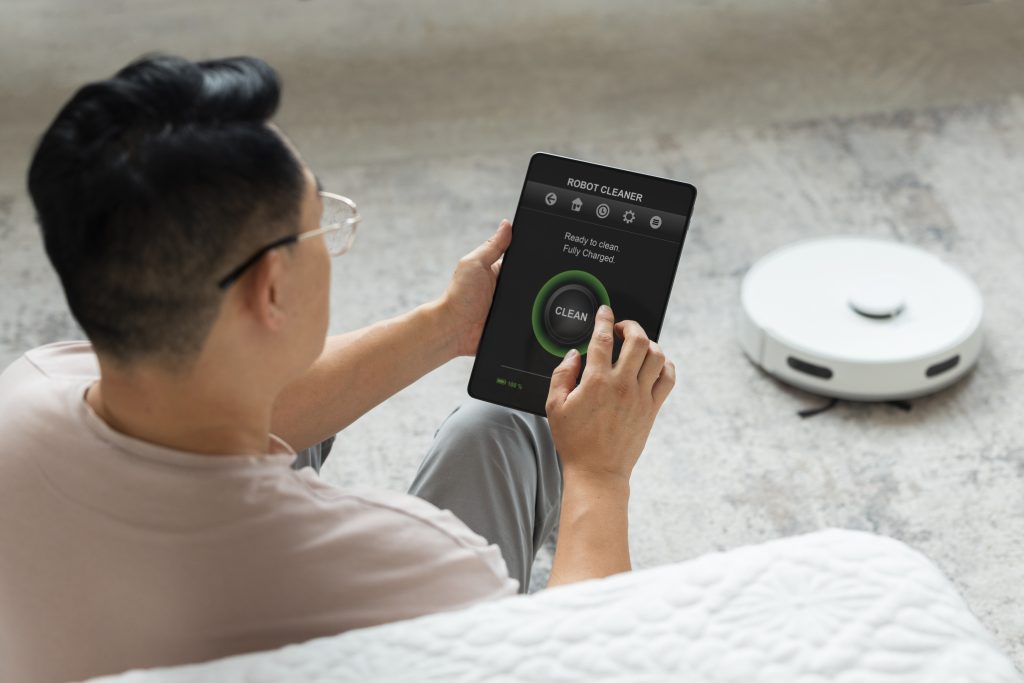Smart Technology That Improves Home Efficiency
Aiden Foster August 19, 2025
Smart homes are no longer merely responsive—they’re becoming truly intuitive. Enter AI-powered ambient sensing, a rapidly emerging trend that allows homes to understand and adapt to your presence, environment, and routines—often without you lifting a finger. Paired with groundbreaking neuromorphic computing, these technologies promise energy efficiency, seamless automation, and privacy by design. In early 2025, innovators like Samsung and Innatera are pushing the boundaries of what a home can do. In this article, we’ll explore how AI-powered ambient sensing and neuromorphic chips are reshaping home efficiency today—and what that means for your comfort, bills, and future living.

1. What Is AI-Powered Ambient Sensing—and Why It Matters
A shift from reactive to proactive automation
Traditional smart home devices require you to initiate commands—voice prompts or app taps. But AI-powered ambient sensing goes further: devices detect motions, sounds, or even behaviors and adjust lighting, climate, and security accordingly.
For example, Samsung’s SmartThings ecosystem is evolving into a platform where everyday devices—TVs, fridges, speakers—become ambient sensors. These appliances can infer household activity and trigger automations such as lighting adjustments or air quality improvements. Crucially, much of the processing happens locally, enhancing both speed and privacy.
Industry experts also highlight how this shift enables homes to anticipate rather than react—adjusting ambiance, energy consumption, cleaning schedules, and even security measures in real time.
AI-powered ambient sensing makes homes feel alive, anticipating your needs for enhanced convenience and truly efficient operation.
2. Low-Power, Smart Performance with Neuromorphic Computing
AI-powered ambient sensing needs brains—and efficient ones. Enter neuromorphic computing, a brain-inspired architecture designed to process events intelligently with minimal energy.
Neuromorphic chips operate differently from traditional processors. Instead of running constantly, they activate only when relevant sensor data arrives. This event-driven approach makes them ideal for devices that must remain “always on” but cannot afford high power consumption, like smart locks, doorbells, or thermostats.
Companies such as Innatera have introduced neuromorphic chips that process sensory input with ultra-low energy use and millisecond-level response. This combination allows smart home systems to stay attentive without straining power bills—or privacy.
3. Key Benefits: Comfort, Savings, Sustainability
Here’s how the convergence of AI-powered ambient sensing and neuromorphic computing reshapes home efficiency:
- Intuitive comfort
Rooms light up as you move in. Climate systems adjust before you even notice temperature changes. Air purifiers activate automatically when pollutants rise. Automation becomes seamless and predictive—without needing app controls. - Lower energy and resource use
Devices operate only when needed. Neuromorphic chips reduce idle energy draw. Homes consume only what’s necessary—and not a watt more. - Improved privacy
With processing happening locally rather than in the cloud, households enjoy stronger data security while still benefiting from advanced, context-aware automation. - Future-proof interactivity
As behavior patterns shift, AI-powered ambient sensing adapts. Integration with standards like Matter ensures scalability and cross-device compatibility.
4. Real-World Innovations: What’s Happening in 2025
Samsung’s SmartThings, becoming ambient
Samsung is positioning SmartThings devices and hubs as ambient sensors, allowing appliances to participate in household monitoring and adaptation. Generative AI tools will further customize layouts and automations, making homes both interactive and predictive.
Homes that anticipate and react
Experts note that modern AI can now anticipate needs—adjusting ambiance, cleaning, and energy use without manual input. This proactive approach ensures homes are more comfortable while reducing waste.
Energy-wise chips: Neuromorphic architecture
Neuromorphic designs such as Innatera’s Pulsar chip showcase the potential of brain-inspired computing. By responding only to meaningful signals, these chips enable low-latency, always-on performance while consuming a fraction of the energy of traditional processors.
5. Emerging Challenges and How to Manage Them
Even with its promise, this trend comes with hurdles:
| Challenge | What It Means | Practical Tip |
|---|---|---|
| Compatibility | Devices from different brands may not work seamlessly | Look for Matter-certified devices, as the Matter standard improves interoperability |
| Initial cost | Advanced sensors and neuromorphic chips can be more expensive upfront | Prioritize high-impact zones (entrance, living area) and scale gradually |
| Privacy concerns | Sensors may feel intrusive | Favor devices with local processing to keep sensitive data in-house |
| Ecosystem lock-in | Some platforms prefer their own ecosystem | Choose flexible ecosystems or Matter-ready options to stay open to change |
6. How to Embrace AI-Powered Ambient Sensing in Your Home: A Step-by-Step Guide
To make your home smarter, start small—then scale up:
- Audit your home’s smart potential
Identify high-traffic areas (entryway, living room) where ambient automation could add the most value. - Upgrade to smart hubs gradually
Invest in a SmartThings hub or Matter-compatible hub to connect devices and support ambient sensing. - Install neuromorphic-enabled devices
Prioritize always-on gadgets like security sensors or thermostats that benefit most from low-power activity awareness. - Define priority automations
- Turn on path lighting as you enter at night
- Adjust HVAC based on occupancy
- Purify air automatically after cooking
- Monitor and refine
Adjust settings as needed to fine-tune comfort and efficiency. - Expand over time
Add sensors, wellness-focused lighting, or advanced AI routines once the foundation is solid.
7. The Future: What’s Next Beyond 2025?
Looking ahead, expect:
- Greater Matter support—seamless interoperability across brands.
- Edge AI and micro-learning—homes that refine routines continuously on-device, minimizing reliance on the cloud.
- Smart city sync—homes collaborating with broader grids for energy efficiency and sustainability.
- Mainstream neuromorphic chips—cost reductions bringing advanced sensing to everyday appliances.
Conclusion
In 2025, AI-powered ambient sensing and neuromorphic computing are reshaping how we experience our homes. Instead of reactively adjusting to commands, homes now anticipate—adapting intuitively as you live. The result is smarter automation, lower energy use, enhanced comfort, and greater privacy.
By starting with a hub, selecting ambient-ready devices, and gradually adding efficient technologies, homeowners can build environments that respond naturally, conserve energy, and truly feel like the future of living.
References
- The Verge. (2025, January 22). Samsung is bringing ambient sensing to SmartThings. Available at: https://www.theverge.com (Accessed: 19 August 2025).
- Homes & Gardens. (2025). How AI anticipates and adapts smart home tech. Available at: https://www.homesandgardens.com (Accessed: 19 August 2025).
- Tom’s Guide. (2025). We’re building chips that think like the brain: Neuromorphic computing in smart devices. Available at: https://www.tomsguide.com (Accessed: 19 August 2025).







